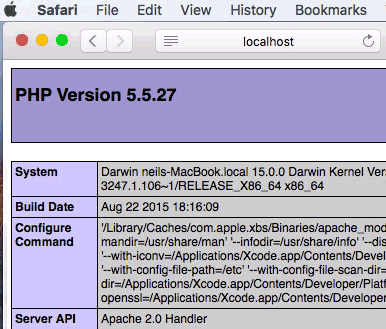- Mac Os X Mysql For Php Converter
- Mac Os X Mysql For Php Server
- Osx Php
- Php Mysql Tutorial
- Mac Os Install Php
- Mac Os X Mysql For Php Mysql
I have been always playing with the Apache, PHP, and MySQL every time but since when I switched to Mac and wanted to make a web development environment on my Mac. So the first step is to install Apache, PHP, and MySQL.
Install Apache for Mac OS
Mac LAMP development with MAMP (Mac OS X, Apache, MySQL, and PHP) First of all, MAMP is a terrific, free all-in-one Mac LAMP/PHP solution. Just download MAMP and install the MAMP folder in your Mac Applications folder, and you're almost ready to start your Mac/Apache/MySQL/PHP project. In fact, if you don't work from the Mac OS X command line. Additionally, it seems that the default installation of php on Mac OS X (10.5 tested) does not point to the default location of the mysql.sock file that is installed in a standard MySQL 5.0 installation. This prevents php working with locally hosted MySQL databases.
Since Mac OS is ultimately built on Unix so it is very to install any Unix supporting software. The most interesting part is that Mac OS comes with the Apache web server and we just need to start it and make some changes to setup our development environment.
Now, We need to start the apache server with root privileges to avoid permission issues.

Therefore, just launch the terminal type the command as follows:-

After starting Apache – test to see if the webserver is working in the browser – http://localhost – you should see the “It Works!” text.
Creating Apache VirtualHosts
The default location for Apache webserver project files is /Library/WebServer/Documents/. In this location, you all can create your application in order to host your web applications.
Mac Os X Mysql For Php Converter

To enable VirtualHosts, we need to make some changes in the Apache Configuration file (httpd.conf).
Make sure that you change your DocumentRoot, ServerName and Directory location according to your needs.
Now your VirtualHosts setup is done now, just restart the apache with command
Mac Os X Mysql For Php Server
Install PHP on Mac OS X
In order to install PHP, in Mac OS you will just need to enable PHP support for Apache, i.e, to need to make changes in its (httpd) configuration file.
Open httpd.conf file with the command as follows:-
Uncomment below the line and save it.
LoadModule php7_module libexec/apache2/libphp7.so
Now restart the server and it should be able to process PHP files. To test it we can create a simple PHP file as below.
Create test.php file in the /Library/WebServer/Documents/ directory with the following lines of code as shown below and save it.
Load the PHP file in browser with URL http://localhost/test.php and you should see a huge page with all the PHP configurations as shown below:-
Congrats now you have successfully installed PHP on your Mac OS.
Osx Php

Installing MySql on Mac OS
Installing MySQL in Mac OS is very simple you will just have to download MySQL dmg file from the MySQL website and just press next, next in order to install.
Download the MySql DMG file from MySql Download Website.
Open the DMG file and install MySql server
Start the MySql server if it’s not running and you can find MySQL in system preferences.
Click on MySQL and you will see the screen as below:-
If you want to control MySQL through your terminal then you will have to add MySQL directory to your shell path, this is done in your “.bash_profile” file in your home directory if you don’t have that file just create it using vi or nano:
Php Mysql Tutorial
open that “.bash_profile” and add the following line and save it.
export PATH=${PATH}:/usr/local/mysql/bin/
Now, you can access MySQL through your terminal, in order to check just type the command as follows:-
Mac Os Install Php
Now, you have successfully connected your MySQL server through your terminal.
If you want to change the MySQL root password then just login to MySQL and the query as follows:-
Change the lowercase ‘MyNewPass’ to what you want – and keep the single quotes.
Mac Os X Mysql For Php Mysql
Now you have successfully installed all your web development environment. If you want to GUI to manage MySQL then you can install MySQL workbench.
If you have any queries do post your questions in the comment section below: 🙂
